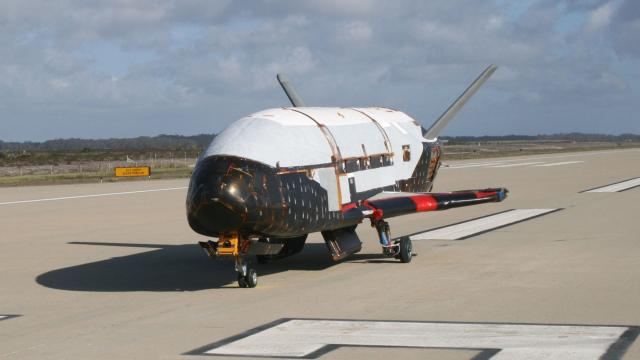The Pentagon’s X-37B space plane will be returning to low Earth orbit later this month. But unlike previous operations, the U.S. military is sharing details about this mission and what the mysterious vehicle will be doing.
The sixth mission of the U.S. Department of Defence’s X-37B Orbital Test Vehicle will involve a satellite deployment and a batch of science experiments, two of which belong to NASA, according to a statement by the U.S. Space Force. This mission will be the first to include a service module for the space plane, which will be used for conducting experiments.
The X-37B is scheduled to launch on May 16 from Cape Canaveral Air Force Station in Florida. An Atlas V rocket will deliver the craft to low Earth orbit, reports SpaceFlightNow. The space plane is an asset of the U.S. Air Force, but the U.S. Space Force will be handling the upcoming launch, orbital operations, and landing.
Developed by Boeing, this reusable vehicle, which performed its first mission in 2010, doesn’t require an onboard crew. Like the Space Shuttle, it enters space atop a rocket, hangs out in low Earth orbit, re-enters the atmosphere when it’s ready to come home, and lands like a conventional plane.
It’s not entirely clear what goes on during these missions, leading to speculation that the space plane is a platform for testing spy satellite technology and other space-based military tech. Officially, however, the DoD says the X-37B is
an experimental test program to demonstrate technologies for a reliable, reusable, unmanned space test platform for the U.S. Air Force. The primary objectives of the X-37B are twofold; reusable spacecraft technologies for America’s future in space and operating experiments which can be returned to, and examined, on Earth.
Or, as U.S. Space Force Chief of Space Operations John Raymond described it in the Space Force statement, the X-37B program exemplifies the “lean, agile and forward-leaning technology development we need as a nation in the space domain.”
The previous X-37B mission was a record-breaker. The vehicle spent a whopping 779 straight days in space, landing on August 27, 2019. The DoD was tight-lipped about the purpose of this mission, describing it only in very broad strokes:
Technologies being tested in the program include advanced guidance, navigation and control, thermal protection systems, avionics, high temperature structures and seals, conformal reusable insulation, lightweight electromechanical flight systems, advanced propulsion systems, advanced materials and autonomous orbital flight, reentry and landing.
Now, the DoD is being unusually candid about the upcoming mission, probably because the space plane won’t be doing anything too sensitive from a security standpoint. The launch will see the deployment of the FalconSat-8, a small satellite built by the U.S. Air Force Academy and sponsored by Air Force Research Laboratory. The satellite will serve as an “educational platform” for five USAFA experiments, the details of which were not disclosed in the statement.
The upcoming mission will be the X-37B’s first to use a service module to run space-based experiments. Located at the rear of the vehicle, the service module will “expand the capabilities of the spacecraft and host more experiments than any of the previous missions,” said Randy Walden from the Air Force Rapid Capabilities Office in a statement.
A pair of NASA experiments will study the effects of radiation on selected materials and the effects of space on seeds meant to grow food. In an experiment being run by the U.S. Naval Research Laboratory, solar power will be converted into radio frequency microwave energy, then relayed to the ground.
[referenced url=” thumb=” title=” excerpt=”]
So, nothing too exciting or controversial, but not altogether unsurprising for a program known for its secrecy. In a weird way, however, the X-37B is delivering in ways the Space Shuttle never did, offering a cheap and easy route to space. With no crew to worry about, the space plane can hang out in orbit for extended periods of time.
It’s a shame the DoD can’t be more forthcoming about the fascinating project, and make it more accessible—and meaningful—to the American public.
